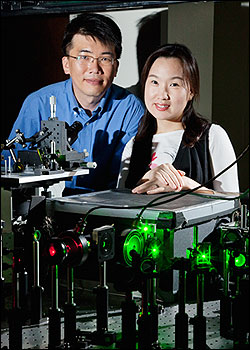
FRET Tracks Single Enzyme
Thanks to a single-molecule imaging technique developed by a University of Illinois professor, researchers have revealed the mechanisms of an important DNA-regulating enzyme.
Helicase enzymes are best known for “unzipping” DNA for replication, but have many other functions for DNA repair and maintenance. The Illinois team focused on a particular bacterial helicase called PcrA involved in preventing unwanted recombination.
A DNA double helix consists of two strands twisted around each other. When one strand is damaged or breaks, the surrounding area is degraded, leaving a single-stranded region. Specialized proteins then start the process of recombination – rebuilding the second strand using the intact DNA as a template.
“Recombination is essential for DNA repair, but if it runs amok, it causes problems,” said physics professor Taekjip Ha. “This helicase controls recombination by removing recombination proteins from the DNA.”

University of Illinois physics professor Taekjip Ha and graduate student Jeehae Park used FRET to study how an important DNA enzyme regulates damaged sections of DNA. The red and green fluorescent dyes allow them to track a single enzyme’s activity. (Photo: L. Brian Stauffer)
Using a technique called single-molecule fluorescence resonance energy transfer (FRET), Ha and his team were able to identify one of the mechanisms that PcrA uses to regulate recombination. The system uses two dyes that change in relative intensity depending on their proximities to one another. The researchers attached the two dyes to the opposite ends of the single-stranded DNA tail.
Helicases are motor proteins, a class of enzymes that use chemical energy to move along a DNA molecule like a train on a track. But using FRET, the researchers observed the two dyes gradually moving closer to each other, then flying apart, repeatedly. Instead of moving along the single-stranded tail, PcrA binds at the point of the break, where the double- and single-stranded regions meet. Then, it uses its motor function to “reel in” the tail, like a sailor pulling in a rope.
“By combining the structure-specific binding of the enzyme to the DNA and the motor function, the enzyme can reel in the DNA and in the process kick off recombination proteins,” said Ha, who is also a Howard Hughes Medical Institute investigator.
When PcrA reaches the end of its DNA rope, it releases it and starts the reeling in process over again, removing any additional problematic proteins that have bound to the damaged DNA.
By using FRET, the team also was able to answer another question about PcrA: How consistent is its motor function? Researchers agree that, on average, PcrA moves one DNA unit, called a base pair, for each unit of cellular energy it uses, called ATP. But because researchers traditionally study the enzyme in relatively large samples, broad distributions of data have led to conflicting views on whether the helicase moves in uniform steps or those of varying lengths – even up to six base pairs per ATP.
Since FRET is a single-molecule technique, the researchers were able to document a single enzyme’s function, step by step, and found that PcrA does, in fact, move in uniform steps of one base pair per ATP. The team published its findings in the August 20 edition of the journal Cell.
Next, the team plans to create a reaction environment more similar to that in vivo, using three and four colors of FRET dyes to measure activities of multiple proteins simultaneously. They are also working toward understanding why helicase moves only in one direction.
“This is an ideal marriage of a new technology and an interesting biological problem,” Ha said.
For more information, visit: www.illinois.edu
Published: September 2010